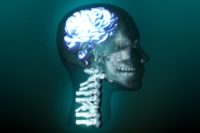 People with poor physical fitness in their 40s may have lower brain volumes by the time they hit 60, an indicator of accelerated brain aging, according to new research presented at the American Heart Association EPI/Lifestyle 2015 meeting.
People with poor physical fitness in their 40s may have lower brain volumes by the time they hit 60, an indicator of accelerated brain aging, according to new research presented at the American Heart Association EPI/Lifestyle 2015 meeting.
“Many people don’t start worrying about their brain health until later in life, but this study provides more evidence that certain behaviors and risk factors in midlife may have consequences for brain aging later on,” said Nicole L. Spartano, Ph.D., lead author and a postdoctoral fellow at the Boston University School of Medicine.
Blood pressure changes can damage brain
A subset of 1,271 participants from the Framingham Offspring Study participated in exercise treadmill testing in the 1970s, when their average age was 41. Starting in 1999, when their average age was 60, they underwent magnetic resonance imaging (MRI) of their brains as well as cognitive tests. The participants did not have heart disease or cognitive problems at the beginning of the study, and none were taking medication that alters heart rate.
In individuals with low fitness levels, the blood pressure and heart rate responses to low levels of exercise are often much higher than in individuals with better fitness.
“Small blood vessels in the brain are vulnerable to changes in blood pressure and can be damaged by these fluctuations,” Spartano said. “Vascular damage in the brain can contribute to structural changes in the brain and cognitive losses. In our investigation we wanted to determine whether exaggerated blood pressure fluctuations during exercise were related to later structural changes in the brain.”
The researchers found:
- People who had a lower fitness level or greater increase in diastolic blood pressure (bottom number) or heart rate a few minutes into the low-intensity treadmill test (2.5 miles an hour) had smaller brain tissue volume later in life.
- People who had a larger increase in diastolic blood pressure during low-intensity exercise also performed more poorly on a cognitive test for decision-making function later in life.
- Poor physical fitness could be associated with accelerated brain aging.
- “For every 3.4 units lower exercise capacity, every 7.1 mm Hg higher exercise diastolic blood pressure, and for every 8.3 beats/minute higher exercise heart rate in midlife, these effects are approximately equivalent to an additional 0.5 years of brain aging,” Spartano said.
- Apart from the exercise tests, a higher resting systolic blood pressure (top number) at age 40 was associated with a smaller frontal lobe volume and a greater volume of white matter hyperintensity (an indicator of loss of blood flow with aging) on the later brain MRIs.
What it means
Promotion of midlife physical fitness may be an important step towards ensuring healthy aging of the brain in the population, researchers said.
“It will be interesting to follow up with these participants in another 10 years to determine how many developed dementia, and if that may be related to their fitness or exercise blood pressure or exercise heart rate in midlife,” Spartano said.
Co-authors are: Jayandra J. Himali, Ph.D.; Alexa S. Beiser, Ph.D.; Charles DeCarli, M.D.; Ramachandran S. Vasan, M.D.; and Sudha Seshadri, M.D.



